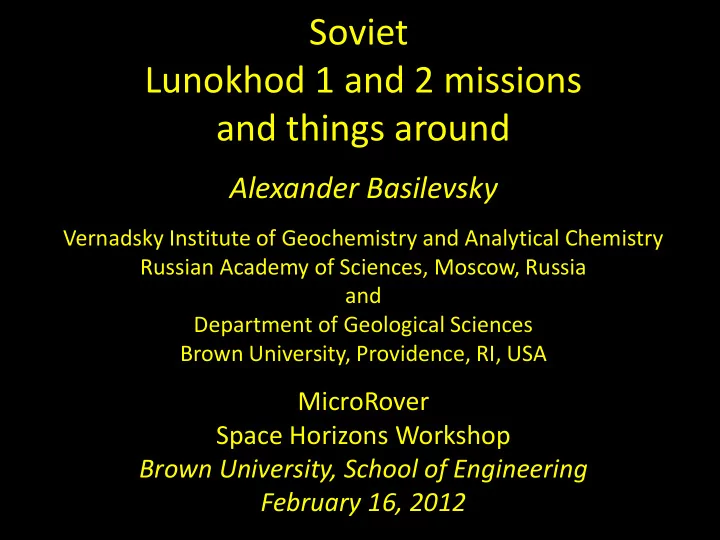

Soviet Lunokhod 1 and 2 missions and things around Alexander Basilevsky Vernadsky Institute of Geochemistry and Analytical Chemistry Russian Academy of Sciences, Moscow, Russia and Department of Geological Sciences Brown University, Providence, RI, USA MicroRover Space Horizons Workshop Brown University, School of Engineering February 16, 2012
Lunokhod 1 and 2 rovers and scientific instruments on them
Space race to the Moon Cold war time flights to the Moon Lunokhod 1 Lunokhod 1 Lunokhod 2 Lunokhod 2 USA USSR Attempts 31 Attempts 48 Successful 22 Successful 21 From Huntress, Moroz, Shevalev, 2003
Lunokhod 1 Mass 750 kg Payload 105 kg Speed 0.8 to 2 km / hour
Lunokhod 1 payload • Frame & Panoramic TV cameras • RIFMA X-ray Fluorescence Spectrometer • X-ray Telescope • PROP Soil Mechanics Sensor • Radiation Detector • Laser Retroreflector PROP 9 th wheel
Lunokhod 2 and its payload • Frame & Panoramic TV cameras • RIFMA X-ray Fluorescence Spectrometer • X-ray Telescope • PROP Soil Mechanics Sensor • Radiation Detector • Laser Retroreflector • UV/Visible Astrophotometer • Magnetometer • Photodetector
Lunokhod 1 and 2 missions
Lunokhod 1 Lunokhod 2 January 16, 1973 November 17, 1970 Crater LeMonier Mare Imbrium Mare Serenitatis
Lunokhod 1 landscapes
Lunokhod 1 • traveled 10,540 m, • sent to Earth more than 50,000 pictures of the navigation TV cameras and more than 200 TV panoramas, • conducted more than 500 lunar soil mechanics tests, • made numerous measurements of the chemical composition of the soil by X-ray-fluorescence technique, • it also had the French-made laser retroreflector for high-precision measurements of the distances between the Moon and Earth.
Lunokhod -2 traverse Lunokhod -1 traverse
Lunokhod 2 landscapes
Lunokhod 2 • traveled 37,450 m, partly along the mare-like surface, partly intruding into hilly terrain of highland type and studying the edges of a 15 km long tectonic trough • sent to Earth more than 80,000 pictures of the navigation TV cameras and 86 TV panoramas, • conducted more than 150 lunar soil mechanics tests, • conducted numerous chemical analyses, • made numerous magnetometric measiurements, • using a photometric standard in the field of view of the panoramic TV cameras measured albedo of various landforms, • using special up-looking photometer studied brightness of the night sky of the Moon as indicator of levitated dust.
The analysis of TV images led to better understanding of the geologic and geophysical processes on the Moon: • It was found that the surface gardening by meteorite impacts was accompanied by a variety of down-slope mass-wasting phenomena. • Joint consideration of local geology, measurements of the soil mechanics, chemical composition and soil albedo led to conclusions on lateral and vertical mixing of lunar mare and highland materials. • Magnetic measurements along the route and on the observation stations led to discovery of small spots of residual magnetization probably formed by the impacts. • Analysis of time variations of the interplanetary magnetic field also registered by the magnetometer led to estimates of the large- scale (100’s km) structure of the Moon interior.
Lunokhod 1 and 2 control center
High-gain antenna operator Driver Commander
Lunokhod crew and their chiefs
Five days after landing of Lunokhod 1
Alexander Kemurdzhian, Georgii Babakin, Chief Designer of Lunokhods Chief Designer of Lavochkin Association Alexander Kemurdzhian, Ivan Kozhedub, WW2 Hero, Oleg Ivanovsky , Deputy Chief Designer of Lavochkin Assoiciation
Oleg Ivanovsky: WW2, work at NPO Energia, escorted Gagarin, work at Lavochkin NPO
Lunokhod tests and crew trainings
Tests in Kamchatka
Crew training in Shkol’naya
Rover’s varieties done by VNIITRANSMASH
Six-wheel version Caterpillar-type version
Rover for Mars 71 Hopper for Phobos 2
Walking rover
Mockup of wheel-walking rover
Wheel-walking rover with changing body
Clean-up in Chernobyl
Tests of Russian Mars rover in Mohave
Tests of Russian Mars rover in Mohave
Rovers of the Future: • High trafficability and long lifetime. • Reasonable self-dependence. • Ability to study targets of interest: - Contact analyses using robotic arm. - Remote analyses with laser and so on. • Combination of rover(s) with sample return.
Vyacheslav Dovgan’, Anton Ivanov, Emily Stewart Lakdawalla, Juergen Oberst and Jennifer Vaughn provided valuable images and other information. Enormous help was provided by Mikhail Malenkov, close associate of Alexander Kemurdzhian. Prof. Mikhail Malenkov can be achieved for questions and discussion by e-mail m.i.malenkov@gmail.com Thank you for your attention! This presentation can bt downloaded from: https://dropbox.brown.edu/download.php?hash=6475d758
Recommend
More recommend